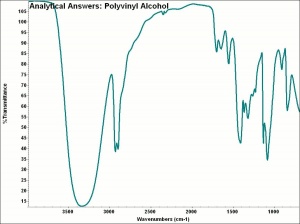Polyvinyl alcohol
Description
A colorless water soluble thermoplastic resin. Polyvinyl alcohol (PVOH) is derived from the hydrolysis of polyvinyl acetate. It was first made in Germany in 1924. PVOH is used as a water-based adhesive and coatings. When the water evaporates, it forms a flexible transparent material. In general, polyvinyl alcohol is resistant to oils, solvents, greases and fungi. It is impermeable to most gases, but has poor moisture resistance. Polyvinyl alcohol is used as an adhesive in packaging and bonding porous material such as cork, leather, and paper. It heats seals at 50-65 C. Polyvinyl alcohol is also used as a modifier in other aqueous systems to improve film forming properties and promote adhesion. It is used for textile sizes, paper coatings, thickeners, printing inks, and to make vinal fibers.
Synonyms and Related Terms
PVOH (standard); PVAL; PVA (incorrect); poli(alcohol vinílico) (Esp.); alcool polyvinylique (Fr.); polivinil alcol (It.); álcool polivinílico (Port.); poly(vinyl alcohol); polyvinylalcohol;
Examples: Elvanol® [DuPont]; Lemol [Borden]; Gelvatol® [Solutia]; Gohsenol [Nippon Synthetic Chemicals]; Mowiol [Hoechst]; Polyviol [Wacker Chemie]:
Other Properties
Turns green when stained with iodine. Softens at 50-65 C.
Soluble in water, dimethylformamide. Insoluble in hydrocarbons, methanol, acetone, diethyl ether.
| Composition | [-CH2CHOH-]n |
|---|---|
| CAS | 9002-89-5 |
| Density | 1.27-1.31 |
| Refractive Index | 1.49-1.53 |
Hazards and Safety
Decomposes in acids, alkalis and with heat. Combustible. Flash point = 79 C (174 F)
Aqueous solutions contain fungicides to prevent mold growth.
Mallinckrodt Baker: MSDS
Comparisons
Physical Properties for Selected Thermoplastic Resins
General Characteristics of Polymers
Sources Checked for Data in Record
- R. J. Gettens, G.L. Stout, Painting Materials, A Short Encyclopaedia, Dover Publications, New York, 1966
- G.S.Brady, Materials Handbook, McGraw-Hill Book Co., New York, 1971 Comment: p. 848
- Theodore J. Reinhart, 'Glossary of Terms', Engineered Plastics, ASM International, 1988
- Richard S. Lewis, Hawley's Condensed Chemical Dictionary, Van Nostrand Reinhold, New York, 10th ed., 1993
- Matt Roberts, Don Etherington, Bookbinding and the Conservation of Books: a Dictionary of Descriptive Terminology, U.S. Government Printing Office, Washington DC, 1982
- Pam Hatchfield, Pollutants in the Museum Environment, Archetype Press, London, 2002
- The Merck Index, Martha Windholz (ed.), Merck Research Labs, Rahway NJ, 10th edition, 1983 Comment: entry 7745
- J.Gordon Cook, Handbook of Textile Fibres:II Man-made Fibres, Merrow Publishing Co. , Durham, England
- Wikipedia, the free encyclopedia, at http://www.wikipedia.com Comment: http://en.wikipedia.org/wiki/Polyvinyl_alcohol (Accessed Feb. 10, 2006)
- Random House, Webster's Encyclopedic Unabridged Dictionary of the English Language, Grammercy Book, New York, 1997
- Book and Paper Group, Paper Conservation Catalog, AIC, 1984, 1989
- Art and Architecture Thesaurus Online, http://www.getty.edu/research/tools/vocabulary/aat/, J. Paul Getty Trust, Los Angeles, 2000
